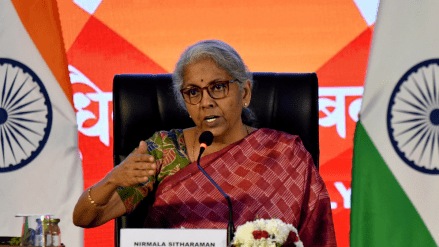Finance Minister Nirmala Sitharaman on Saturday called upon banks to try and address the widening asset-liability mismatch caused by their preference for short-term large deposits, by being aggressive on the “old-fashioned way” of collecting deposits from a wider section of customers.
The minister’s exhortation of the banks during her customary post-Budget address to the central board of the Reserve Bank of India (RBI) came close on the heels of the RBI’s in its bi-monthly monetary policy on Thursday asking the banks to use their wide branch network, and come up with innovative products and services to mobilise deposits.
The relative inability of banks to attract long-term deposits is amidst a shift of household savings towards other financial products, including equity instruments.
“Both RBI and the government have been asking banks to focus on their business activity… they should be aggressive in deposit mobilisation and then lend. That is the core activity of banks,” Sitharaman said. “RBI has given them (banks) some liberty in managing the interest rates. Using that liberty, they should make deposits attractive… bring innovative products and mobilise deposits,” she added. The advice to banks is to shun lazy banking and focus on small savers, rather than big or bulk deposits, of 1-3 years maturity bucket, which they have been focusing on in recent quarters. Retail deposits typically tend to be of tenures longer than three years.
“Big (bulk) deposits have always been a very lazy banker’s job. But the trickles which come are the ones which are going to be bread and butter money to bank on for lending regularly,” Sitharaman said.
RBI governor Shaktikanta Das said the central bank has proactively cautioned the banks on credit-deposit mismatch issues.
While there will (always) be some kind of a mismatch between deposit growth and credit growth, one has to watch out on this and how persistent it is, Das said.
“We have been witnessing about 300 to 400 basis points gaps between deposits and credit growths (for the last few months),” Das said.
However, the governor added that as it stands today, RBI did not see a crisis or anything, but he added “it has to be attended.” “It’s a kind of a proactive cautioning for the bank managements that going forward, this may create structural issues concerning liquidity management,” he said.
Sitharaman said she would be meeting with the banks soon to discuss various issues including priority sector lending, the emphasis needed on some of the government schemes, and also in that process, talk to them about “how they need to go back to collecting deposits in the old-fashioned way from everyone.”
The RBI has given banks some liberty in managing interest rates, which banks should use to make deposits attractive in the banks as retail investors have many other options to look for higher returns such as the equity market, she said. Das also said banks have autonomy to set interest rates, as interest rates on both deposits and lending are deregulated.
In the monetary policy statement, the RBI had said that banks were taking greater recourse to short-term non-retail deposits and other instruments of liability to meet the incremental credit demand.
Das said low-cost current account savings account (CASA) deposits, which were about 43% of overall deposit about a year ago, has come down to about 39%. Therefore, banks also need to focus more on these deposits, not just some bulk deposits, he added.
